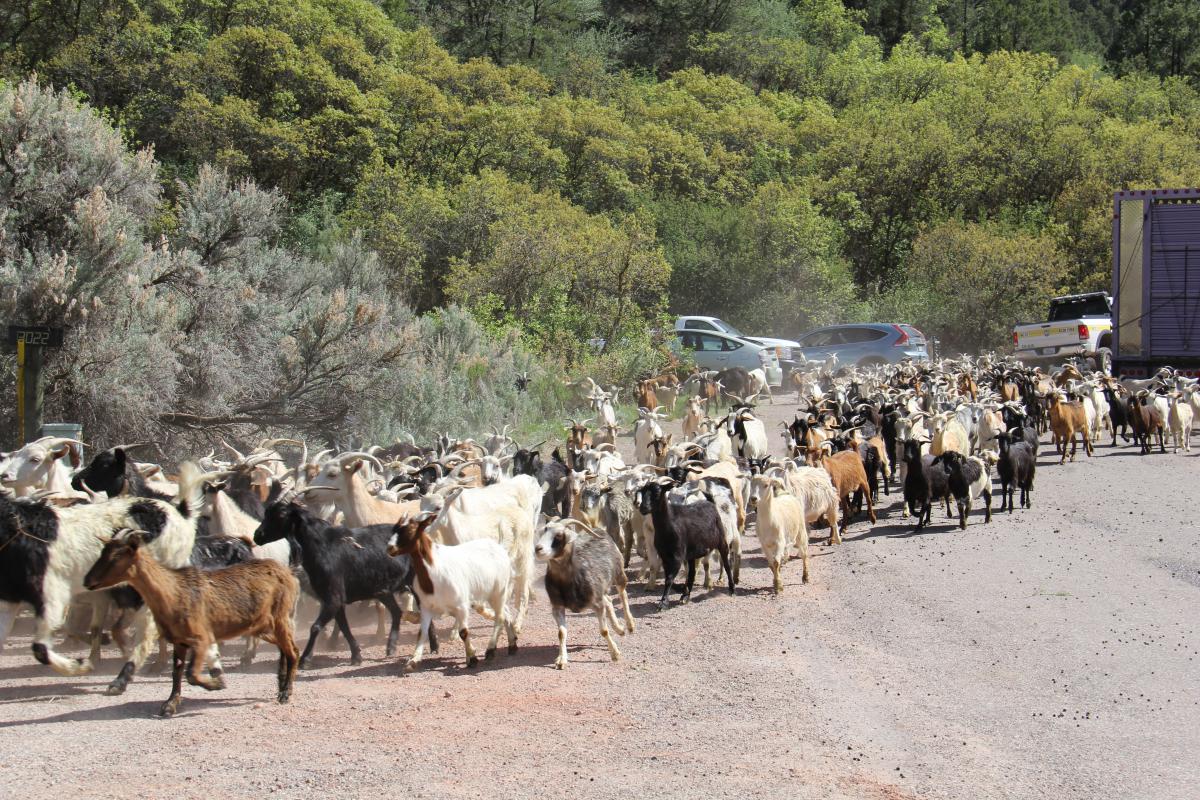
By Kathleen Shannon KDNK Community Radio
The BLM is trying a different land management method on its recently acquired Sutey Ranch in Carbondale. KDNK’s Kathleen Shannon has more on the story.
Listen here:
More than 1,100 goats unloaded from two semi-trucks up Cattle Creek Road in Carbondale last week. They were destined to dine on the overgrown pastures of Sutey Ranch. The Bureau of Land Management acquired this 557-acre parcel and its historic water rights as part of a land exchange in 2017. The property had historically been used as a cattle ranch.
“The fields have been planted with crested wheat and smooth brome for livestock forage, but when BLM wrote the management plan for the ranch, it was decided to manage it primarily for the benefit of wildlife. But those ag fields that were seeded with a monoculture of one or two grass species do not provide very good wildlife habitat.”
That’s Carla DeYoung an ecologist for the BLM, whose research stands behind the Sutey Ranch project. It’s unusual for the BLM to work in areas of historic pasture and it doesn’t typically employ domesticated animals, but new challenges present opportunities.
“We’ve done some literature research on goat grazing and other people have had great success using them, so we were excited to give it a try on this particular situation since it seemed ideal to use goats on these irrigated fields.”
So what role do goats have in this situation? Well, they’re the opposite of grazers.
“Goats are browsers so they prefer brush, trees, cactus – anything pokey, anything poisonous, and everything that nothing else eats.”
Lani Malmberg is in charge of the herd at Sutey Ranch. She’s been operating her business Goat Green LLC for 26 years with her son Donny. Though she has roots in cattle ranching, Lani’s interests in goats grew from her master’s degree in weed science. While many of her fellow graduates wound up working for chemical companies, Loni’s values brought her to the world of goats.
“This is 4400 hoofs which are tilling, mulching, aerating the soil, breaking up these pedestaled up clumps of this Bunch grass that has never been stepped on so 4400 hooves coming through – that’s a hundred thousand pounds. A 100,000 pounds of a living, tilling, grooming machine that is doing all these things at the same time and they’re self-propelled. And with these Border Collie dogs, we can make the speed of the herd change, and the direction change, which you get a whole different tillage action when you do that.”
Because of tight turns on the road, the ranchers and their border collie colleagues had to herd the goats up about a mile of road to enter Sutey Ranch. Lani says the herd is accustomed to frequent movement – the goats have worked in 15 western states.
“They’ve seen it all. And they’re just a fabulous trained herd of goats that have purpose and they know they’re on the job.”
The goats are born and die within the herd and some breeds are better for this type of work than others.
“My favorite breed is Cashmere Spanish what type of Spanish goat because I like mine wild, skinny, very well-behaved, and hungry. It’s not a meat breed. I mean people who are in production agriculture have meat goats and they raise them and get them fat and then sell them for meat. Our goats work their whole lives for me and everything is based on behavior.”
Most of this goat training and good behavior comes from the herd’s genetic line.
“We have the ancestors — and the successors — for 26 years. We have 26 generations of goats and they have herd memory and gut memory of every place we’ve ever been and every poisonous plant that we’ve ever eaten and every difficult situation and their memory is passed down through the generations.”
The goats will eat what’s undesirable at Sutey Ranch and it’s up to the BLM to decide what to replace those plants. Carla and her team select a replacement species that are not only good for wildlife but also have a chance of surviving in depleted soils.
“We seeded the fields prior to bring into goats out with 3 forbs species and the goats will help to reduce the cover of grasses, open up some space for the forbs to grow, and their hosts will help incorporate the seed into the soil, and their urine and feces will help fertilize the seed and also help build up the organic matter in the soil. Two of the forbs that we chose are nitrogen fixers, meaning that they will help improve the soil nutrients for other species, and all of the forbs are very palatable for deer and elk, as well as the bees and other pollinators, and birds also like to eat the wildflower seeds that we chose.”
When the goats finish their work here, they’ll move on to the Lake Christine wildfire area. Lani will send a different herd along the Roaring Fork Transit Authority bike path later this summer, as she has the past several years. It’s challenging to coordinate all this movement, Lani says, but it’s worth it.
“To me, it’s a great adventure, everything is a great adventure. Because like I said everything I own has four legs or four wheels and you move all the time, and we meet the greatest people in the world, and we’ve been on some most the most beautiful landscapes you could even imagine and we’re right there in the camper right with our herd and then we move on to the next most beautiful situation that you ever saw.”
KDNK News, I’m Kathleen Shannon
